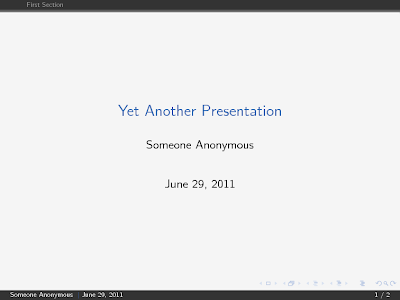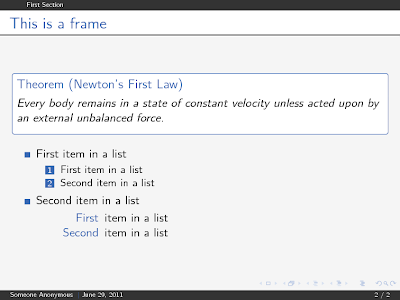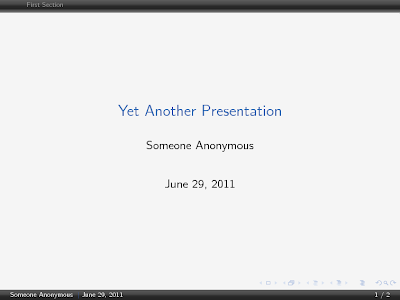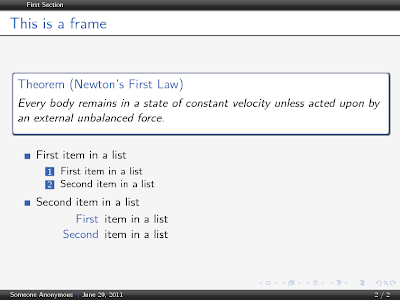(Thanks to
Packt for the complimentary eBook copy for this review.)
When I read about the publication of the book on various forums and blogs, my interest was definitely piqued: the author,
Stefan Kottwitz, is a frequent and helpful contributor/moderator on
TEX.SX. On the other hand I wondered if anyone would actually want to buy an introductory book to
LaTeX, considering the many free tutorials and eBooks available on the Web
(although there are many out-of-date ones, so beware! See some recommended ones at the end of this post).
After a quick flip — erm, clicks with the mouse — through my complimentary eBook copy courtesy of
Packt, I felt the answer was a very firm “
YES”. First off, this is certainly an up-to-date book with descriptions of recent packages, and warnings about obsolete ones. While the first few chapter headings read like most other beginner’s guide to
LaTeX, Kottwitz’s approach of using complete step-by-step examples
throughout the book is something seldom seen in other books or tutorials. By that I mean you don’t just get the first few handful of “Hello World” examples, but for much more advanced usage scenarios as well. (
BTW, The examples are based on
TeXLive and
TeXworks.)
Your mileage may vary, but I do feel that such a hand-holding approach
(that’s what my training course had been described as) — at least in the early days of learning
LaTeX — is very reassuring. Especially so since
LaTeX can be rather intimidating for people who have only used
WYSIWYG word processors before. Pop quizzes are interspersed throughout the content
(answers in the appendix).
The book has 13 chapters on the following topics:
- Getting Started with LaTeX
- Formatting Words, Lines, and Paragraphs
- Designing Pages
- Creating Lists
- Creating Tables and Inserting Pictures
- Cross-Referencing
- Listing Content and References
- Typing Math Formulas
- Using Fonts
- Developing Large Documents
- Enhancing Your Documents Further
- Troubleshooting
- Using Online Resources
While the early chapter headings are kind of expected of any beginner’s guides, they do still contain valuable nuggets. For example, the
microtype package is introduced in Chapter 2, as is how to define your own macros with
\newcommand. Imagine a beginner’s joy at the even more beautiful typesetting afforded by
microtype. And the new-found freedom of defining one’s own commands for consistent typesetting of certain materials. Personally I think such tips, introduced at an early stage, would boost beginner’s confidence in using
LaTeX.
While some might consider the installation instructions of TeXLive and TeXworks in Chapter 1 as frivolous, I certainly welcome the instructions on how to install extra packages in Chapter 11.
Chapter 3 on designing pages is particularly useful, as this seems to be one of the most frequently asked beginner’s questions these days.
(at least, indicated by the fact that the post on setting page sizes and margins being the 5th all-time most favorite post on this blog.)
I also like the mention of
getnonfreefonts in the chapter on fonts. Another favorite chapter of mine is that on Troubleshooting, as this is definitely one of the most important skills if one is to use (and learn!)
LaTeX. And everyone who’s going to write a thesis or a business report will definitely want to read Chapter 10 on large documents.
Overall, the book does cover everything a beginner should learn about
LaTeX,
IMHO anyway. My only nitpicks are that the
LaTeX logo isn’t typeset ‘properly’ in the text; and that the
LaTeXed output images seem a tad blurry in the PDF eBook version. But these are just petty nitpicks, really.
So do I recommend
LaTeX Beginner’s Guide for people interested in learning
LaTeX? I’d say Yes. This would be a very nice addition to libraries, or as a communal copy in a research lab, so that newly registered graduate students who’re not yet quite busy with their research can spend their first month learning up
LaTeX with it. (You can, of course, get your very own copy; I only mention a communal copy as I know some Malaysians — especially poor grad students — might be reluctant to fork out about RM120 for a book. Everyone really should fork out money to buy a good book sometime, though.)
The book is
available as a printed copy (£25.19), eBook copy (£16.14), or multi-format (£28.04).
Shipping is free if you’re in UK, US, Europe, Brunei, Hong Kong, Indonesia, Japan,
Malaysia, Philippines, Korea, Singapore, Thailand, China, Macau and Taiwan — sweet!
Further Reading
Having said all that, you’ll probably want to complement this beginner’s guide with other, more reference-typed books, such as the
LaTeX Companion (I don’t know if the books are available separately), as well as some free
(often rather shorter) tutorials and eBooks:
- Getting to Grips with LaTeX. A personal favorite short beginner’s tutorial.
- The LaTeX WikiBook. A nice quick online reference.
- LaTeX and Friends. This is truly a very comprehensive up-to-date eBook for reference purposes (but it does not have complete examples as Kottwitz’s book does). I understand that the author is still updating it from time to time.




